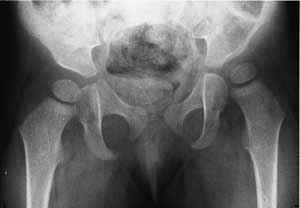Developmental dysplasia (dislocation) of the hip (DDH) is an abnormal formation of the hip joint in which the ball on top of the thighbone (femur) is not held firmly in the socket. In some instances, the ligaments of the hip joint may be loose and stretched. The condition is found in babies or young children.
The degree of hip looseness, or instability, varies in DDH. In some children, the thighbone is simply loose in the socket at birth. In other children, the bone is completely out of the socket. In still other children, the looseness worsens as the child grows and becomes more active.

Pediatricians screen for DDH at a newborn's first examination and at every well-baby checkup thereafter. When the condition is detected at birth, it can usually be corrected. But if the hip is not dislocated at birth, the condition may not be noticed until the child begins walking. At this time, treatment is more complicated and uncertain.
Left untreated, DDH can lead to pain and osteoarthritis by early adulthood. It may produce a difference in leg length or a "duck-like" gait and decreased agility. If treated successfully (and the earlier the better), children regain normal hip joint function. However, even with appropriate treatment, especially in children 2 years or older, hip deformity and osteoarthritis may develop later in life.
The hip is a ball and socket joint. The ball, called the femoral head, forms the top part of the thigh bone (femur) and the socket (acetabulum) forms in the pelvic bone. In some newborns, the socket is too shallow and the ball (thigh bone) may slip out of the socket, either part of the way or completely. One or both hips may be involved. The cause is unknown. Low levels of amniotic fluid in the womb during pregnancy can increase a baby's risk of DDH. Other risk factors include:
There may be no signs of hip dysplasia. Symptoms that may occur can include:
Nonsurgical Treatment: Treatment methods depend on the child's age.
Surgical Treatment
If hip dysplasia is found in the first few months of life, it can almost always be treated successfully with a positioning device (bracing). In a few cases, surgery is needed to put the hip back in joint. Hip dysplasia that is found after early infancy may lead to a worse outcome and may need more complex surgery to fix the problem.
Bracing devices may cause skin irritation. Differences in the lengths of the legs may persist despite appropriate treatment. Untreated, hip dysplasia will lead to arthritis and deterioration of the hip, which can be severely debilitating.